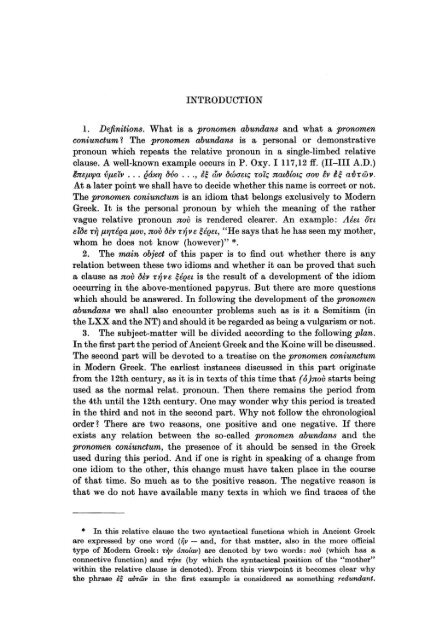Pronomen Abundans and Pronomen Coniunctum. A ... - DWC
Pronomen Abundans and Pronomen Coniunctum. A ... - DWC
Pronomen Abundans and Pronomen Coniunctum. A ... - DWC
Create successful ePaper yourself
Turn your PDF publications into a flip-book with our unique Google optimized e-Paper software.
INTRODUCTION<br />
1. Definitions. What is a pronomen abundans <strong>and</strong> what a pronomen<br />
coniunctum 1 The pronomen abundans is a personalor demonstrative<br />
pronoun which repeats the relative pronoun in a single-limbed relative<br />
clause. A well-known example occurs in P. Oxy. I 117,12 tI. (Il-IIl A.D.)<br />
lnef//'pa v!-'etV .. . éáxrJ ~o ..., è~ WV I5cóauç ro'iç natMotç aov lv t~ avrwv.<br />
At a later point we shall have to decide whether this name is correct or not.<br />
The pronomen coniunctum is an idiom that belongs exclusively to Modern<br />
Greek. It is the personal pronoun by which the meaning of the rather<br />
vague relative pronoun nov is rendered clearer. An example: Ais, on<br />
eMe rij !-,rJdea !-,ov, nov l5èv r~ve Ueet, "He says that he has seen my mother,<br />
whom he does not know (however)" *.<br />
2. The main object of this paper is to find out whether there is any<br />
relation between these two idioms <strong>and</strong> whether it can be proved that such<br />
a clause as nov l5èv r~ve ~ieet is the result of a development of the idiom<br />
occurring in the above-mentioned papyrus. But there are more questions<br />
which should be answered. In following the development of the pronomen<br />
abundans we shall also encounter problems such as is it a Semi ti sm (in<br />
the LXX <strong>and</strong> the NT) <strong>and</strong> should it be regarded as being a vulgarism or not.<br />
3. The subject-matter will be divided according to the following plan.<br />
In the first part the period of Ancient Greek <strong>and</strong> the Koine will be discussed.<br />
The second part will be devoted to a treatise on the pronomen coniunctum<br />
in Modern Greek. The earliost instances discussed in this part originate<br />
from the 12th century, as it is in texts of this time that (ó Jnov starts being<br />
used as the normal relat. pronoun. Then there remains the period from<br />
the 4th until the 12th century. One may wonder why this period is treated<br />
in the third <strong>and</strong> not in the second part. Why not follow the chronological<br />
order? There are two reasons, one positive <strong>and</strong> one negative. If there<br />
exists any relation between the so-called pronomen abundans <strong>and</strong> the<br />
pronomen coniunctum, the presence of it should be sensed in the Greek<br />
used during this period. And if one is right in speaking of a change from<br />
one idiom to the ot her , this change must have taken place in the course<br />
of that time. So much as to the positive reason. The negative reason is<br />
that we do not have available many texts in which we find traces of the<br />
* In this relative clause the two syntactical functions which in Ancient Greek<br />
are expressed by one word (ijv - <strong>and</strong>, for that matter, also in the more official<br />
type of Modern Greek: .rJv óno{av) are denoted by two words: nov (which has a<br />
connective function) <strong>and</strong> TljvE (by which the syntactical position of the "mother"<br />
within the relative clause is denoted). From this viewpoint it becomes clear why<br />
the phrase è~ aVrwv in the first example is considered as something redundant.
















